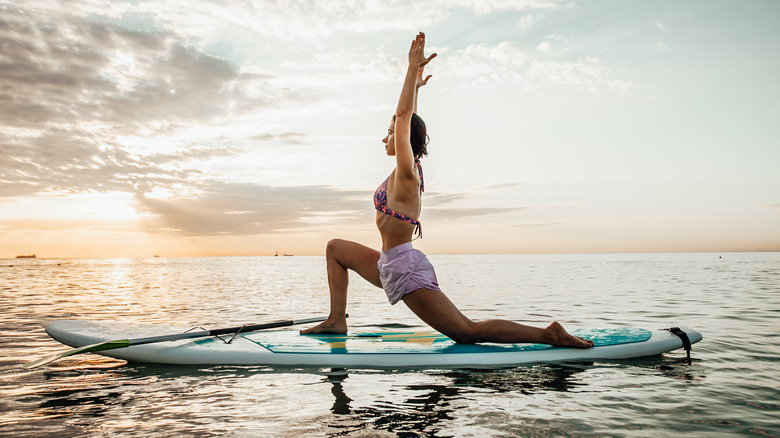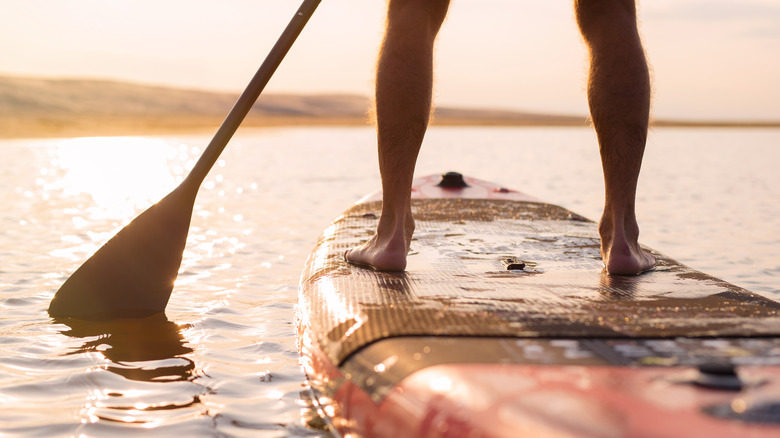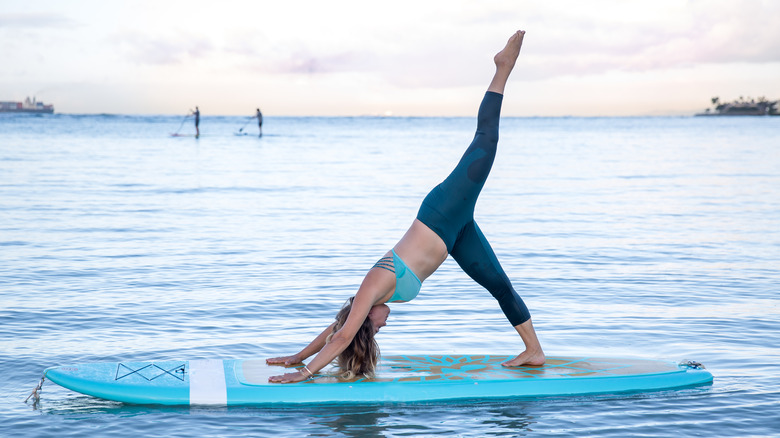What Muscles Are You Working When Doing SUP Yoga?
Yoga can be great to relieve stress, help you sleep, and support your mental health, according to the National Center for Complementary and Integrative Health. Yoga also builds muscle because you challenge your muscles when you hold poses longer or progress through different variations of poses (via LiveScience). Certain poses can target specific muscles. For example, holding chair pose primarily works your arms and legs. Warrior Three strengthens the glutes and hamstrings while you balance on a single leg (via Healthline).
Yoga can also challenge the muscles of your core, according to a 2017 article in the International Journal of Yoga. Poses like chaturanga and side plank work the external obliques, which are core mobilizers. You can target the core stabilizers like the internal obliques and the transverse abdominis through poses like triangle and forearm plank.
If you take your yoga practice to a standup paddleboard (SUP), you'll probably find yourself challenged much more in these poses than on land. You'll also target other muscles as you paddle to your aquatic studio.
Muscles you work on your paddleboard
According to Glide SUP, you get a full-body workout on a paddleboard. Like regular yoga, you'll be barefoot on a paddleboard, which works tiny muscles of your feet to help stabilize you on the board. Your hamstrings and quads are crucial to your balance, absorbing any wobbling from nearby waves.
Obviously, paddle boarding certainly gives you a solid arm workout. However, if your arms get rapidly tired while paddling, your paddle stroke needs adjustment, according to Men's Journal. Two other major muscle groups you work while paddle boarding are your back and core. Your core twists and bends to dip the paddle into the water, and your core and back pull the paddle towards you during the power part of the stroke.
Your shoulders will also get a good workout as they lift and dip the paddle, and your arms work to help drive the paddle stroke (via Glide SUP). After you get a full body warm-up on the paddle board, you can settle into your SUP yoga practice.
Challenging your stability in SUP yoga
According to Yoga Journal, you'll need to keep your center of gravity near the handle of the board. You'll also want to move a little more slowly than you would during your typical vinyasa yoga class on land. SUP yoga requires you to pay a lot more attention to how your body is situated on the board, so you can't zone out, according to Prevention. Pressing down equally on your feet and hands is much more necessary here. This means you'll be engaging more of the intrinsic muscles to help keep you stable. For example, the intrinsic muscles of your core include your transverse abdominis and your internal obliques (via Dynamic Chiro). By working these intrinsic muscles on a paddleboard, you'll improve your land-based yoga practice (via Prevention). You'll also feel more aware of how you favor one side of the body over the other. For example, you'll notice how one hip might drop in bird dog pose, but SUP yoga forces you to address these imbalances.
According to Glide SUP, yoga on a paddle board challenges your nervous system and fires more muscle fibers than doing the same practices on land. For example, chair pose on a paddleboard will work your legs more because you're also working the stabilizer muscles to keep you balanced. SUP yoga will help you tune into your body much more because if you don't, you'll wind up in the water.



